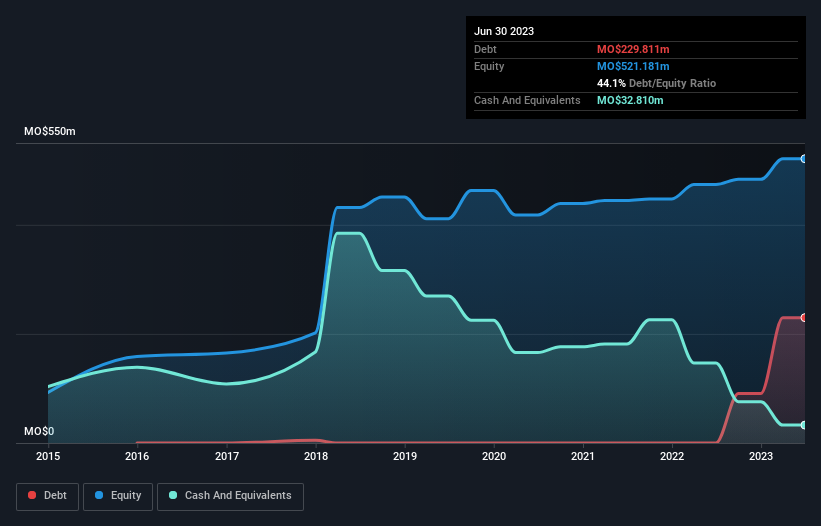Warren Buffett famously said, 'Volatility is far from synonymous with risk.' So it seems the smart money knows that debt - which is usually involved in bankruptcies - is a very important factor, when you assess how risky a company is. As with many other companies MECOM Power and Construction Limited (HKG:1183) makes use of debt. But the more important question is: how much risk is that debt creating?
When Is Debt A Problem?
Debt assists a business until the business has trouble paying it off, either with new capital or with free cash flow. In the worst case scenario, a company can go bankrupt if it cannot pay its creditors. However, a more usual (but still expensive) situation is where a company must dilute shareholders at a cheap share price simply to get debt under control. Having said that, the most common situation is where a company manages its debt reasonably well - and to its own advantage. When we think about a company's use of debt, we first look at cash and debt together.
See our latest analysis for MECOM Power and Construction
What Is MECOM Power and Construction's Net Debt?
The image below, which you can click on for greater detail, shows that at June 2023 MECOM Power and Construction had debt of MO$229.8m, up from none in one year. However, it does have MO$32.8m in cash offsetting this, leading to net debt of about MO$197.0m.

A Look At MECOM Power and Construction's Liabilities
According to the last reported balance sheet, MECOM Power and Construction had liabilities of MO$566.6m due within 12 months, and liabilities of MO$43.3m due beyond 12 months. Offsetting this, it had MO$32.8m in cash and MO$698.4m in receivables that were due within 12 months. So it can boast MO$121.3m more liquid assets than total liabilities.
This surplus suggests that MECOM Power and Construction has a conservative balance sheet, and could probably eliminate its debt without much difficulty.
We use two main ratios to inform us about debt levels relative to earnings. The first is net debt divided by earnings before interest, tax, depreciation, and amortization (EBITDA), while the second is how many times its earnings before interest and tax (EBIT) covers its interest expense (or its interest cover, for short). This way, we consider both the absolute quantum of the debt, as well as the interest rates paid on it.
MECOM Power and Construction's net debt to EBITDA ratio of about 1.8 suggests only moderate use of debt. And its commanding EBIT of 32.6 times its interest expense, implies the debt load is as light as a peacock feather. Shareholders should be aware that MECOM Power and Construction's EBIT was down 21% last year. If that earnings trend continues then paying off its debt will be about as easy as herding cats on to a roller coaster. When analysing debt levels, the balance sheet is the obvious place to start. But it is MECOM Power and Construction's earnings that will influence how the balance sheet holds up in the future. So if you're keen to discover more about its earnings, it might be worth checking out this graph of its long term earnings trend.
Finally, a company can only pay off debt with cold hard cash, not accounting profits. So it's worth checking how much of that EBIT is backed by free cash flow. Over the last three years, MECOM Power and Construction saw substantial negative free cash flow, in total. While that may be a result of expenditure for growth, it does make the debt far more risky.
Our View
MECOM Power and Construction's EBIT growth rate and conversion of EBIT to free cash flow definitely weigh on it, in our esteem. But its interest cover tells a very different story, and suggests some resilience. When we consider all the factors discussed, it seems to us that MECOM Power and Construction is taking some risks with its use of debt. While that debt can boost returns, we think the company has enough leverage now. The balance sheet is clearly the area to focus on when you are analysing debt. However, not all investment risk resides within the balance sheet - far from it. These risks can be hard to spot. Every company has them, and we've spotted 3 warning signs for MECOM Power and Construction (of which 1 can't be ignored!) you should know about.
When all is said and done, sometimes its easier to focus on companies that don't even need debt. Readers can access a list of growth stocks with zero net debt 100% free, right now.
New: Manage All Your Stock Portfolios in One Place
We've created the ultimate portfolio companion for stock investors, and it's free.
• Connect an unlimited number of Portfolios and see your total in one currency
• Be alerted to new Warning Signs or Risks via email or mobile
• Track the Fair Value of your stocks
Have feedback on this article? Concerned about the content? Get in touch with us directly. Alternatively, email editorial-team (at) simplywallst.com.
This article by Simply Wall St is general in nature. We provide commentary based on historical data and analyst forecasts only using an unbiased methodology and our articles are not intended to be financial advice. It does not constitute a recommendation to buy or sell any stock, and does not take account of your objectives, or your financial situation. We aim to bring you long-term focused analysis driven by fundamental data. Note that our analysis may not factor in the latest price-sensitive company announcements or qualitative material. Simply Wall St has no position in any stocks mentioned.
About SEHK:1183
MECOM Power and Construction
Offers construction services in Macau, Hong Kong, Cyprus, and the People’s Republic of China.
Adequate balance sheet with questionable track record.
Market Insights
Community Narratives



